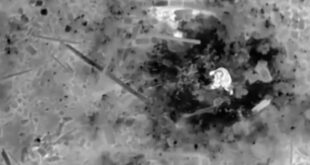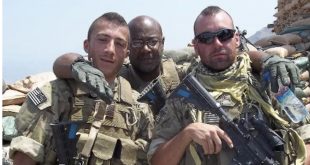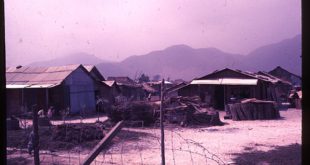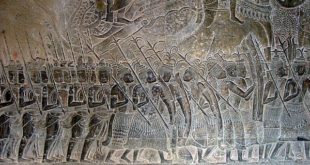UPDATE:
Is the Warlord Dostum back? The “famous” warlord and the former Vice President of Afghanistan, Abdul Rashid Dostum is finally back, celebrating his return with a vow to “suppress” the Taliban., the Sentinel reported as Doatrom was reportedly in or heading for Afghanistan recently . ‘I predicted this years ago. Now that such a situation has come, it is our home, I have been raised there… I will be proud if I am killed and martyred there’
A video recently showed dozens of Taliban fighters inside the palace of Abdul Rashid Dostum, a former warlord who commands thousands of fighters, after the insurgents took over the strategic city of Mazar-i-Sharif in Afghanistan.p, AlArabiya reports. Dostum is one of two of Afghanistan’s most notorious regional strongmen who fled on Saturday as the northern city of Mazar-i-Sharif fell to the Taliban and security forces abandoned the city in a headlong rush up the highway to the safety of neighboring Uzbekistan.
Another report from India claims that “ Major Afghan army commander Rashid Dostum is reported to have reached the Panjshir Valley, where Afghan Vice President Amrullah Saleh and Afghan politician Ahmed Shah Masood are already present. He is on the warpath against the Taliban supposedly.
The Last Warlord: The Life and Legend of Dostum, the Afghan Warlord Who Led US Special Forces to Topple the Taliban Regime
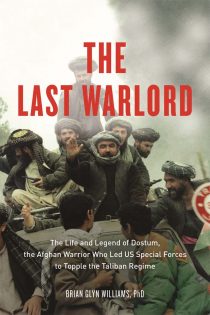
Brian Glynn Williams. (Chicago Review, 2013) 334 pp.
Reviewed by J. R. Seeger
The past 40 plus years of conflict in Afghanistan have given us a number of charismatic characters fit for future biographies. But to date, the lives of only four of these individuals have been captured in books in the English language: Hamid Karzai, Jalaluddin Haqqani, Ahmed Shah Massoud, and the subject of this review, Abdul Rashid Dostum.[1] Of the four, Dostum perhaps has been the least well known but consistently the most maligned player in the conflict.
After hours of extensive interviews, author Brian Williams has worked hard to match Dostum’s descriptions of his life and times with what few records are available. He has used surviving documents from the Soviet Union and the Democratic Republic of Afghanistan (DRA) that corroborate Dostum’s description of his life in the 1980s as the head of the DRA Uzbek militia forces as well as press and other unclassified sources. These materials tend to focus heavily on the dread the Uzbeks inspired in the resistance—the Uzbeks were referred to at the time as the gilamjam (literally, carpet thieves or plunderers).
There is little more in the unclassified literature covering Dostum’s life after the DRA, as his activities in the north were eclipsed by those of Ahmad Shah Massoud and the Taliban’s religious and ethnic cleansing efforts throughout Afghanistan and particularly in the north. After 9/11, once US forces linked up with Dostum that fall, US official reports and journalistic accounts match most, if not all, of Dostum’s descriptions of events.
The arc of Dostum’s multiple careers in the military and in government could easily be viewed as the model of leadership survival through decades of conflict, when Afghan leaders often changed sides to live and fight another day, used their charisma to hold their followers, and courted luck to succeed. Dostum grew up in a rural village of Jowzjan and only found his professional calling after he was drafted into national military service. He progressed from private to commander of the Uzbek militia through charisma, practical military skills, and ambition. His progressively more prominent successes brought him to the attention of the last leader of the DRA, Mohammad Najibullah.
Before he asssumed national leadership, Najibullah had led the Afghan security service and come to understand the value of using Uzbek militias in Pashtun-dominated southern and eastern Afghanistan. The Uzbeks had no love for Pashtuns, and they were especially hostile to the Afghan resistance, which was increasingly influenced by Islamic fundamentalist dogma openly hostile to the Hanafi/Sufi doctrines of northern Afghan Islam. Dostum and his militia were successful in virtually every battle they fought, and even when they were not, DRA propagandists disguised their failures in order to preserve the Uzbek’s reputation as invincible raiders.
Once the Soviets left Afghanistan, Najibullah was forced for his own preservation to seek reconciliation with the resistance, and Dostum and the Uzbeks became liabilities. After a short-lived alliance with Massoud, Dostum withdrew to the north, where he controlled his home province until the Taliban took control. After suffering a defeat to the Taliban, Dostum escaped at the last minute to Uzbekistan and went into a brief exile in Turkey. He returned to Afghanistan in early 2001, with the help of his former adversary, ally, and rival, Massoud.
Dostum’s descriptions of his guerrilla operations in the mountains in Samangan as provided to Williams are rich in detail. Dostum is an excellent raconteur and has a memory for military detail. His descriptions of how his militia conducted ambush and raiding operations for more than 40 years provide a wealth of tactical and technical information that make Williams’s book worthwhile reading for any professional in the intelligence or special operations communities interested in unconventional warfare.
Dostum’s description of events after after 9/11 can be matched against declassified Special Forces dispatches and other published material. This part of the story has been described in Doug Stanton’s The Horse Soldiers, Gary Schroen’s First In, Gary Bernsten’s Jawbreaker,[2] and the dispatches of multiple journalists, including Robert Pelton, who lived with Dostum for several weeks after the Taliban recaptured Mazar-e-Sharif. Williams makes good use of this material in corroborating and enhancing Dostum’s recollections and analysis and summarizing unclassified descriptions. The result is a page-turning story of resistance fighters with US counterparts on horseback.
Williams hints at, but does not address, the longstanding links that Dostum has had with both the Hazara Shia of Central Afghanistan and the Ismaili Shia of Samangan provinces, links that involved military alliances during the entire 40 years of conflict. Dostum’s ability to engage and build military alliances with other ethnic minorities is one of his key leadership qualities and one that has been essential to his success in unconventional warfare.
The last chapters of the book offer a balanced discussion of the post-Taliban problems among the various military figures in the North. Both Dostum and his Tajik counterpart and rival, Mohammed Atta, faced a Kabul-centric national government run by Hamid Karzai, a Pashtun leader more comfortable with the intricacies of tribal politics of the area South of the Hindu Kush than with the multiethnic challenges of the North. The Tajiks who became part of the central government, all from the Panjshir Valley, were hostile to Uzbeks, Turkmen, and Hazaras of Central Afghanistan and even Tajiks from the far west such as Ismail Khan. They were barely supportive of Tajiks like Atta, who eventually became a successful governor of Balkh Province.
Unlike most of the figures from the region who worked hard to come to some accommodation with the central government, Dostum and his entourage were more aggressive, demanding some degree of recognition of the Uzbek minority. The central government under Karzai responded, reinforcing the ethnic prejudices and exaggerations of Dostum’s character and pressing Dostum to once again live in exile.
The book ends with Dostum’s return from exile in 2009 and his reinstatement in a nominal position in the government in 2009. In the aftermath of political machinations, and as the 2014 presidential elections in Afghanistan approach, Dostum is now a candidate for vice president, allied with the Pashtun presidential candidate Ashraf Ghani Ahmadzai, the former minister of finance, and Hazara Shia Sarwar Danish, candidate for second vice president.
A challenge Williams faced in writing this biography was how to address accusations that Dostum not only is a warlord but a “war criminal.” Williams alludes to this in the first few pages of the book when he expresses concern over his personal safety at his first meeting with Dostum in 2003. Williams knew he was about to meet a man who had been accused of atrocities for nearly 40 years. Williams points out that most of those stories were (and continue to be) told as “absolutely true” even though no one in Afghanistan, Pakistan, or the West can find any eyewitness reporting. While Williams had no doubt that Dostum was a man of violence, he simply could not accept stories that Dostum “crushed men’s skulls with his bare hands or had a laugh that frightened men to death.” (12–13) Throughout the book, Williams points to the consistent conflict between the exaggerations about Dostum and the gilimjam and the data provided by eyewitness accounts he collected himself or obtained from other sources.
Dostum’s Jowzjani militia established a reputation over 40 years of war as the most lethal fighting force in Afghanistan. As a military leader Dostum perpetuated this reputation to erode his enemies’ will to fight as he built his credibility as a regional and national political figure, and at times he has been willing to expand this image almost to absurdity. At the same time, Dostum’s adversaries use some of the same stories to undermine him.
Given the mix of fact and fiction and the benefits to all sides of perpetuating different parts of Dostum fiction, it is likely no one will ever be able to come to a balanced understanding of his place in Afghan history. Williams does his best to undermine some of the more egregious claims and offers a more nuanced view of the realities of the vicious 40-year civil war and one of its chief actors.
The Last Warlord captures a larger than life character who has been on nearly every side of the Afghan conflict in the last 40 years. Williams has not only superbly portrayed Dostum as a hero to his Uzbek people but also as a real person whose personal and professional flaws in part explain his relegation to a regional rather than a national role in Afghanistan. For this reason alone, I strongly recommend this work to readers who want to understand an important Afghan figure as a human being living in a country in seemingly perpetual conflict.
Finally, I think it is worth observing that “war stories” are usually the memories of adrenaline-filled observers living through violence. For this reason, until the US government declassifies all the material collected by the Special Forces and CIA personnel on the ground in the fall of 2001, it is unlikely that any single book or article will capture fully what really happened in Northern Afghanistan during September–December 2001. This book gives readers the rare perspective of an Afghan leader who lived through 40 years of conflict before the defeat of the Taliban.
 Soldier of Fortune Magazine The Journal of Professional Adventurers
Soldier of Fortune Magazine The Journal of Professional Adventurers


